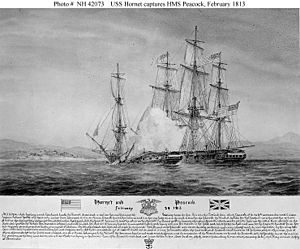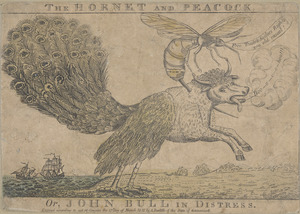Sinking of HMS Peacock facts for kids
Quick facts for kids USS Hornet vs HMS Peacock |
|||||||
|---|---|---|---|---|---|---|---|
| Part of the War of 1812 | |||||||
 USS Hornet captures HMS Peacock, February 1813 |
|||||||
|
|||||||
| Belligerents | |||||||
| Commanders and leaders | |||||||
| James Lawrence | William Peake | ||||||
| Strength | |||||||
| 1 sloop of war 165 Marines and Sailors |
1 brig sloop 122 Marines and Sailors |
||||||
| Casualties and losses | |||||||
| 5 killed (3 drowned) 4 wounded (1 mortally) |
1 brig sunk 17 killed (9 drowned) 33 wounded (3 mortally) |
||||||
The sinking of HMS Peacock was a sea battle during the War of 1812. It happened on February 24, 1813, near the Demerara River in Guyana. The fight was between an American warship, the USS Hornet, and a British warship, the HMS Peacock. After a short but fierce fight, the Hornet won. The Peacock was so badly damaged that it sank soon after giving up.
Contents
Getting Ready for Battle
On October 26, 1812, two American warships, the frigate USS Constitution and the sloop Hornet, left Boston, Massachusetts. They were supposed to be joined by another ship, the frigate USS Essex, but it was being repaired. The ships tried to meet up, but it didn't work out.
In December, the Constitution and Hornet arrived off Salvador, Bahia in Brazil. There, they found a British warship, the HMS Bonne Citoyenne. The American commander, William Bainbridge, challenged the British captain to a fight. But the British captain refused because his ship was carrying a lot of valuable gold and silver.
Bainbridge left the Hornet to keep an eye on the Bonne Citoyenne. He then sailed south and later sank another British frigate, the HMS Java.
On the Hornet, Commander James Lawrence learned that a large British warship was expected. On January 24, 1813, the HMS Montagu appeared. Lawrence quickly sailed into safe waters belonging to Portugal. After dark, he headed north along the coast of South America. On February 14, the Hornet captured a British mail ship, the Resolution, which was carrying $20,000 in gold and silver.
The Battle Begins
On February 24, Commander Lawrence and the Hornet chased a British merchant ship into the mouth of the Demerara River. As evening came, Lawrence saw two British warships. One, the HMS Espiegle, was anchored in the river. The other, the Peacock, was sailing towards them from the sea.
The Hornet sailed against the wind to get into a better position. Lawrence then turned his ship. As the Hornet and Peacock sailed past each other, they fired their cannons. They were very close, only "half pistol shot" away. The British shots mostly went too high, but some American sailors were hurt. The Peacock was hit hard in its main body.
Captain Peake of the Peacock tried to turn his ship to use his other side of cannons. But Lawrence was faster. The front right side of the Hornet came up against the back of the Peacock. From this position, the British could not fire their guns. The Hornet's gunners then badly damaged the Peacock in just four minutes.
Captain Peake was killed. His first officer quickly surrendered and sent out a signal for help. Even though the Espiegle was nearby and could see the fight, it did not try to help. The Espiegle's captain later said he didn't know a battle was happening.
Who Was Hurt?
The British lost 5 sailors who were killed, and 33 were wounded. Three of the wounded later died. The Americans had only one sailor killed and four wounded. One of the wounded later died. Most of the American injuries happened during the Peacock's first cannon attack.
After the Fight
Both ships dropped anchor. The Peacock's main mast fell down. An American crew went onto the Peacock to try and fix the holes below the water. They also tried to throw cannons overboard to make the ship lighter. But the Peacock suddenly sank. Three American sailors and nine British sailors were trapped inside and drowned.
The Peacock sank in only about 33 feet (10 meters) of water. Four British sailors saved themselves by climbing the foremast, which stayed above the water. Four others escaped to the shore in a boat during the confusion.
The sailors who survived from the Peacock were taken aboard the Hornet. There were already other British prisoners from captured merchant ships. With some American sailors from a recaptured ship, the Hornet was now carrying 277 people.
The Hornet then sailed towards Martha's Vineyard, a place on the American coast that the British navy was not watching. Even so, everyone on board suffered from a lack of water when they arrived on March 19. The surviving officers of the Peacock said that the Hornets crew treated them very kindly. Eventually, the Peacocks officers and crew were sent back to Britain in June.
The Peacock had smaller cannons than the Hornet. The Peacock had eighteen 24-pounder carronades, while the Hornet had eighteen 32-pounder carronades. But the big defeat was probably more because the British crew was not well-trained and didn't practice enough with their guns. It was said that Captain Peake cared more about how his ship looked than how well it could fight.
Remembering the Battle
The sinking of the Peacock was quickly celebrated in the United States. People made pictures and wrote songs about it.
An artist named Amos Doolittle created a picture called The Hornet and Peacock, Or, John Bull in Distress. It was published on March 27, 1813. The picture shows a creature that is half-bull and half-peacock being stung in the neck by a hornet. The hornet says, "Free Trade and Sailor's Rights you old rascal!"
His brother, Eliakim Doolittle, wrote a song at the same time. The first part of the song goes:
Ye Demo's attend and ye Federalists too,
I'll sing you a song that you all know is new,
Concerning a Hornet, true stuff, I'll be bailed,
That tickled the Peacock and lowered his tail,
Another cartoon called John Bull stung to agony by the Wasp and Hornet was published on March 1, 1813. It also used the saying "Huzza for 'Free Trade and Sailor's Rights'". This cartoon also mentioned the victories of another American ship, The Wasp. This cartoon is now in the Historical Society of Pennsylvania.
Images for kids



